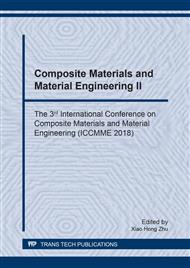[1]
M. Gupta, V. Singh, R. Kumar, and Z. Said, A review on thermophysical properties of nanofluids and heat transfer applications, Renew. Sustain. Energy Rev., vol. 74, pp.638-670, (2017).
DOI: 10.1016/j.rser.2017.02.073
Google Scholar
[2]
H. Zhu, Y. Lin, and Y. Yin, A novel one-step chemical method for preparation of copper nanofluids, Journal of Colloid and Interface Sci., vol. 277, pp.100-103, (2004).
DOI: 10.1016/j.jcis.2004.04.026
Google Scholar
[3]
S. Suresh, K.P. Venkitaraj, P. Selvakumar, and M. Chandrasekar, Synthesis of Al2O3-Cu / water hybrid nanofluids using two-step method and its thermophysical properties, Colloids Surf. A Physicochem Eng. Asp., vol. 388, pp.41-48, (2011).
DOI: 10.1016/j.colsurfa.2011.08.005
Google Scholar
[4]
S.E. AbdElhafez, A.H. El-Shazly, and A.S. El-Maghraby, Improving the rate of solar heat recovery from nanofluids by using micro heat exchanger, Desalination and Water Treatment, vol. 57, pp.23066-23073, (2016).
DOI: 10.1080/19443994.2016.1157987
Google Scholar
[5]
Marwa El kady, H. Shokry, and H. Hamad, Effect of superparamagnetic nanoparticles on the physicochemical properties of nano hydroxyapatite for groundwater treatment: adsorption mechanism of Fe (II) and Mn (II), RSC Advances, vol. 6, pp.82244-82259, (2016).
DOI: 10.1039/c6ra14497g
Google Scholar
[6]
M.F. Elkady, and H. Shokry, Equilibrium and dynamic profiles of azo dye sorption onto innovative nano-zinc oxide biocomposite, Current Nanoscience, vol. 11, pp.805-814, (2015).
DOI: 10.2174/1573413711666150415003115
Google Scholar
[7]
H. Xie, W. Yu, and W. Chen, MgO nanofluids : higher thermal conductivity and lower viscosity among ethylene glycol-based nanofluids containing oxide nanoparticles, Journal of Experimental Nanoscience, vol. 5, pp.463-472, (2010).
DOI: 10.1080/17458081003628949
Google Scholar
[8]
A.S. Shehata, A.H. El-Shazly, A.A. Zaatout and G.H. Sedahmd, Mass transfer behaviour of a new liquid-liquid rotating screen disc extractor, Bulg. Chem. Commun., vol. 43, pp.427-438, (2011).
Google Scholar
[9]
A.H. El-Shazly, Augmentation of the performance of batch electrocoagulation unit by using gas sparging, Defect and Diffusion Forum, vol. 312, pp.700-707, (2011).
DOI: 10.4028/www.scientific.net/ddf.312-315.700
Google Scholar
[10]
A.H. El-Shazly and M.A. Daous, Investigations and Kinetics Study for the Effect of Solution Flow Rate on the Performance of Electrocoagulation Unit Used for Nutrients Removal, Int. J. Electrochem. Sci., vol. 8, pp.12509-12518, (2013).
Google Scholar
[11]
M. Hemmat, and M. Hadi, Rheological characteristics of MgO / oil nanolubricants : Experimental study and neural network modeling, Int. Commun. Heat Mass Transf., vol. 86, pp.245-252, (2017).
DOI: 10.1016/j.icheatmasstransfer.2017.05.017
Google Scholar
[12]
K.G. Rao, C.H. Ashok, K.V. Rao, and C.S. Chakra, Structural properties of MgO nanoparticles: synthesized by co-precipitation technique, Int. J. Science and Research, pp.43-46, (2014).
Google Scholar
[13]
A. Rashidi, H. Ahmadi, S.S. Mohtasebi, and P. Mahnaz. Thermal and rheological properties of oil-based nanofluids from different carbon nanostructures, Int. Commun. Heat Mass Transf., vol. 48, pp.178-182, (2013).
DOI: 10.1016/j.icheatmasstransfer.2013.08.004
Google Scholar
[14]
D. Sui, V.H. Langåker, and Z. Yu. Investigation of Thermophysical Properties of Nanofluids for Application in Geothermal Energy, Energy Procedia, vol. 105, pp.5055-5060, (2017).
DOI: 10.1016/j.egypro.2017.03.1021
Google Scholar
[15]
E.V. Timofeeva, A.N. Gavrilov, and others, Thermal conductivity and particle agglomeration in alumina nanofluids: experiment and theory, Physical Review E, vol. 76, pp.061-203, (2007).
DOI: 10.1103/physreve.76.061203
Google Scholar
[16]
A. Asadi, and others. Heat transfer efficiency of Al2O3-MWCNT / thermal oil hybrid nanofluid as a cooling fluid in thermal and energy management applications: An experimental and theoretical investigation, Int. J. Heat Mass Tras., vol. 117, pp.474-486, (2018).
DOI: 10.1016/j.ijheatmasstransfer.2017.10.036
Google Scholar


